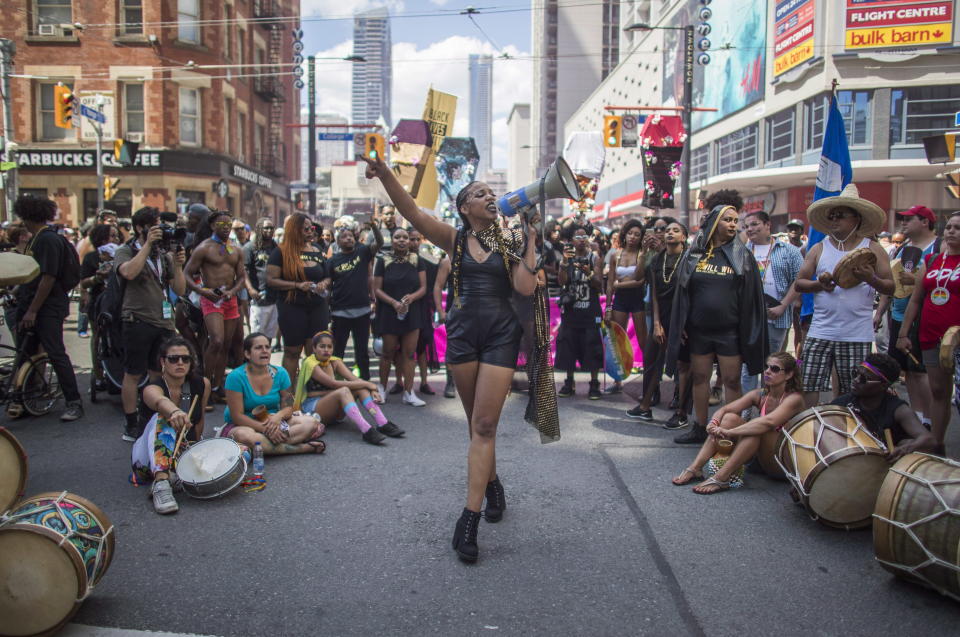Vote: Should Toronto police have withdrawn their application to march in the city’s Pride parade?
Toronto’s police have withdrawn their application to march in the city’s Pride parade later this year after Pride Toronto asked them to do so.
In a statement made Tuesday, Toronto Police Chief Mark Saunders said he hopes the move “will be received as a concrete example” of the fact that he is listening closely to the community’s concerns.
On Monday night, Pride Toronto called investigations into the deaths of six men, some of whom have been connected to the city’s gay village, “insufficient.” Pride Toronto also says the community’s worries a serial killer was targeting men in the neighborhood were “dismissed” by police.
“We recognize steps have been taken to work in collaboration and consultation to understand what we need to be safe. This will not be accomplished in one day,” the Toronto Pride statement said. “Marching won’t contribute towards solving these issues; they are beyond the reach of symbolic gestures.”
Bruce McArthur, 66, faces first-degree murder charges in connection with the men’s deaths.
The case has renewed tensions between the city’s LGBTQ community and its police. Some activists say when community members tried to share information with police about some of the missing men in the neighborhood, their concerns “were not necessarily taken seriously by officers,” according to The Canadian Press.
Other LGBTQ organizations also signed Pride Toronto’s statement, saying trust “cannot be mended through a parade,” The Canadian Press reports.
In February, Saunders prompted anger in the LGBTQ community when he suggested an arrest could have been made sooner if people had been more cooperative with investigators.
According to Huffpost Canada, Saunders told The Globe and Mail “nobody” came to police with information in 2012 when Project Houston, an unsuccessful investigation into the disappearances of multiple men, was launched.
“The community tried to tell them, ‘We think it’s a serial killer, we think that the cases are related, we think that there’s a possibility that it was all tied to one of the [dating] apps or something like that, that there has to be a link,’ and they assured us that there wasn’t,” community member Alphonso King told The Canadian Press in January. “They completely dismissed that notion.”
This is not the first time the city’s LGBTQ community and its police have come into conflict.
Toronto’s police and the city’s LGBTQ have had a strained relationship for decades. In 1981, the city’s police raided four gay bathhouses, and arrested more than 250 men in what was then called “Project Soap.” The outrage and protest following the raids evolved into the city’s Pride week. In 2016, Saunders made a formal apology for the raids.
But the Toronto Women’s Bathhouse Committee refused to accept Saunders’ apology.
In 2016, Chanelle Gallant, an activist who was at the Club Toronto bathhouse during a 2000 raid by Toronto police, told The Globe and Mail the committee believed the apology was not good enough since it did not address ongoing issues that remain in the community. Saunders did not mention that 2000 raid in his apology, according to the Toronto Star.
“It leaves out the criminalization and violent targeting of radicalized, indigenous and marginalized groups within and outside of LGBTQ communities,” Gallant told The Globe and Mail.
“There is no justice for any of us until there is justice for all of us.”

In 2017, Toronto police officers were not allowed to attend the Pride parade in their uniforms, according to The Canadian Press. Weapons, cruisers, and police floats were also banned. This was due to a situation in which Black Lives Matter Toronto halted the 2016 Pride parade and asked Pride Toronto agree to a list of demands.
Then, BLMTO said the police presence in the parade would make those in marginalized communities feel unsafe due to the strained relationship between Toronto police and the city’s black community, The Canadian Press reports.
So, what do you think? Should Toronto’s police service have withdrawn its application to march in Pride? Let us know by voting in the poll above.
With files from The Canadian Press and Huffpost Canada.


